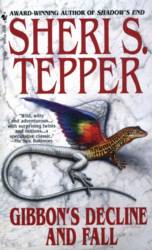

| Click on a book's image or title to order from Amazon.com |

Gibbon's Decline And Fall
Bantam, PB, © 1996, 465 pp, ISBN #0-553-57398-5Reviewed November 1997
Gibbon's Decline And Fall takes place in the year 2000: A radical right-wing group, the American Alliance, has become a major player in US politics, and is allied with fundamentalist groups across the globe. Under their influence, a major backlash against women's rights is occurring, with groups of men becoming overt and assaulting women who don't fit their traditional standards. Against this backdrop we meet seven friends who attended college together in the late 1950s, and we see where each of them has gone with their lives, their marriages, and their careers. One of them has died, but each of the others has the feeling that she's still with them, somehow.
The first quarter of the book is skillfully written, but not especially artful. It seems like a textbook case of introducing us to each of the six women in great detail, and as such comes off as rather boring, since it consistent mainly of exposition. It also introduces us to the Alliance (a clear rip-off of the real-life Christian Coalition), its global leader, L.S. Webster, and Jake Jagger, an up-and-coming district attorney who has rationalized his difficult childhood and uncaring mother by seeing women as minor tools to be used, and nothing more. Although much of this is true-to-life, it is not presented with much sophistication, so it feels all-too-cliched.
The book does finally take off as we learn that a strange virus has been released into the general population, which has reached full bloom: The chemical make-up of humans is becoming altered, and men are losing their sex drive and violent impulses, while all people under the age of roughly 30 seem to be going through a reversal of puberty. While panicking many people, it especially disturbs the Alliance, which is counting on the basic violent nature of men to effect their takeover of the world.
In the midst of this, Carolyn, the book's nominal protagonist, takes a case to defend a teenaged girl against Jagger, who is prosecuting her for the murder of her newborn child. This girl, Lolly Ashaler, is a barely functional human being having been largely ignored by her parents and raped to become pregnant. Jagger and the Alliance plan to use this case to start his political career. Jagger, it turns out, is completely corrupt, blackmailing the presiding judge, and having abused his wife into submission.
And on top of that, the women, who have their annual reunion during the trial, suspect that their late member, Sophy, was responsible for releasing the virus, and decide to track down her people - supposedly Native Americans - to find out what they can about her. They eventually track her origins to southern New Mexico, where it turns out that she was in fact a member of a race of lizard-people, who had descended in parallel to humanity, who are few in number, live in seclusion, and are parthenogenic.
The middle of the book is very readable: The study of the virus is interesting, and even the lizard-people are a reasonable science fictional hook. But the book stumbles badly at the end: It turns out that L. S. Webster is some sort of primal force who feeds off of human pain, and is hugely powerful. In creating this character, Tepper effectively prevents the problem from being soluble by her human protagonists, and they can thus only be saved by Sophy's spirit (or 'ghost', if you will), which seems all too deus ex machina. Then, Sophy provides the women with a choice, which would change the nature of the virus and alter the way in which human reproductivity works, fundamentally changing our nature. Although Carolyn does finally make the choice, we aren't told what she chose! This resulted for me in frustration of throw-the-book-against-the-wall variety. Basically, Tepper is unwilling to pick a position and defend it, which makes me wish she hadn't included that choice at all.
I would have much preferred if the ending had been scaled back and treated as serious science fiction, rather than flat-out fantasy.
On the whole, the book is somewhat shallow as far as examining humanity's social problems, even the gender-based ones. It doesn't offer any solutions, and I didn't have a problem with that. Of far more interest is her examination of the women and men in the book, particularly how the men treat the women: There are a couple of kind and faithful men, several abusive ones, one who treats his wife as a trophy, and one who trolls around for other women, including the other women in the book's spotlight. The characters are not quite three-dimensional, but the actions are put into clear relief, and - at least for me - resulted in a consideration of how I treat women, and how I perceive them as being treated.
Gibbon's Decline And Fall is not a great book, but it is a reasonably thoughtful one, and one which prompted a lengthy and lively discussion in our local book discussion group.
Note: I wrote some more comments about reading this book in my on-line journal, in the 11 Nov, 12 Nov, and 13 Nov 1997 entries.
hits since 13 August 2000.